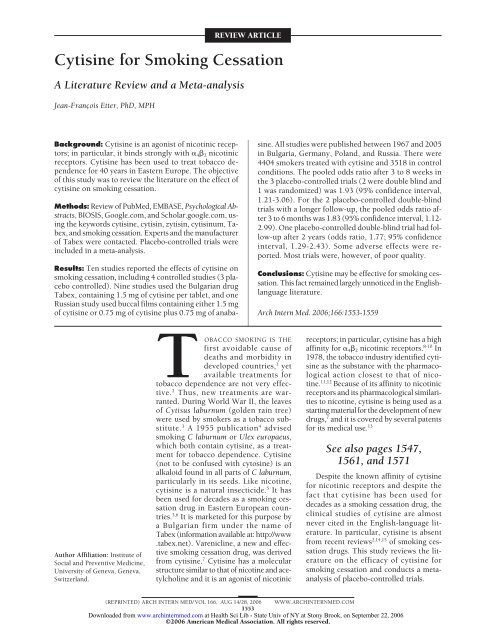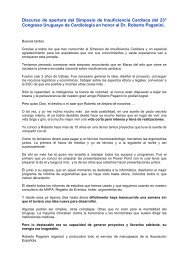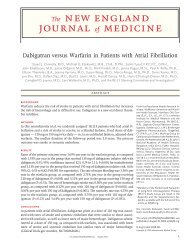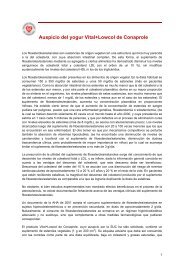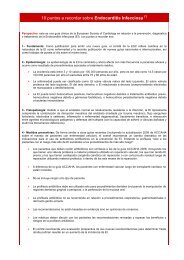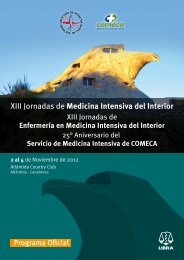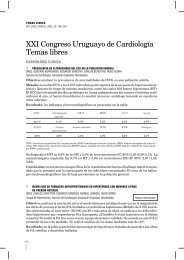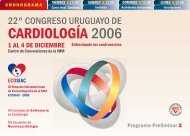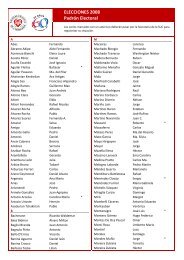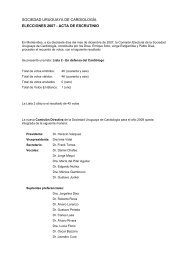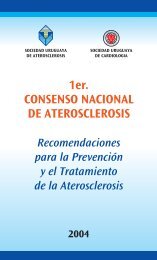You also want an ePaper? Increase the reach of your titles
YUMPU automatically turns print PDFs into web optimized ePapers that Google loves.
REVIEW ARTICLE<br />
<strong>Cytisine</strong> <strong>for</strong> <strong>Smoking</strong> <strong>Cessation</strong><br />
A Literature Review and a Meta-analysis<br />
Jean-François Etter, PhD, MPH<br />
Background: <strong>Cytisine</strong> is an agonist of nicotinic receptors;<br />
in particular, it binds strongly with 4 2 nicotinic<br />
receptors. <strong>Cytisine</strong> has been used to treat tobacco dependence<br />
<strong>for</strong> 40 years in Eastern Europe. The objective<br />
of this study was to review the literature on the effect of<br />
cytisine on smoking cessation.<br />
Methods: Review of PubMed, EMBASE, Psychological Abstracts,<br />
BIOSIS, Google.com, and Scholar.google.com, using<br />
the keywords cytisine, cytisin, zytisin, cytisinum, Tabex,<br />
and smoking cessation. Experts and the manufacturer<br />
of Tabex were contacted. Placebo-controlled trials were<br />
included in a meta-analysis.<br />
Results: Ten studies reported the effects of cytisine on<br />
smoking cessation, including 4 controlled studies (3 placebo<br />
controlled). Nine studies used the Bulgarian drug<br />
Tabex, containing 1.5 mg of cytisine per tablet, and one<br />
Russian study used buccal films containing either 1.5 mg<br />
of cytisine or 0.75 mg of cytisine plus 0.75 mg of anabasine.<br />
All studies were published between 1967 and 2005<br />
in Bulgaria, Germany, Poland, and Russia. There were<br />
4404 smokers treated with cytisine and 3518 in control<br />
conditions. The pooled odds ratio after 3 to 8 weeks in<br />
the 3 placebo-controlled trials (2 were double blind and<br />
1 was randomized) was 1.93 (95% confidence interval,<br />
1.21-3.06). For the 2 placebo-controlled double-blind<br />
trials with a longer follow-up, the pooled odds ratio after<br />
3 to 6 months was 1.83 (95% confidence interval, 1.12-<br />
2.99). One placebo-controlled double-blind trial had follow-up<br />
after 2 years (odds ratio, 1.77; 95% confidence<br />
interval, 1.29-2.43). Some adverse effects were reported.<br />
Most trials were, however, of poor quality.<br />
Conclusions: <strong>Cytisine</strong> may be effective <strong>for</strong> smoking cessation.<br />
This fact remained largely unnoticed in the Englishlanguage<br />
literature.<br />
Arch Intern Med. 2006;166:1553-1559<br />
Author Affiliation: Institute of<br />
Social and Preventive Medicine,<br />
University of Geneva, Geneva,<br />
Switzerland.<br />
TOBACCO SMOKING IS THE<br />
first avoidable cause of<br />
deaths and morbidity in<br />
developed countries, 1 yet<br />
available treatments <strong>for</strong><br />
tobacco dependence are not very effective.<br />
2 Thus, new treatments are warranted.<br />
During World War II, the leaves<br />
of Cytisus laburnum (golden rain tree)<br />
were used by smokers as a tobacco substitute.<br />
3 A 1955 publication 4 advised<br />
smoking C laburnum or Ulex europaeus,<br />
which both contain cytisine, as a treatment<br />
<strong>for</strong> tobacco dependence. <strong>Cytisine</strong><br />
(not to be confused with cytosine) is an<br />
alkaloid found in all parts of C laburnum,<br />
particularly in its seeds. Like nicotine,<br />
cytisine is a natural insecticide. 5 It has<br />
been used <strong>for</strong> decades as a smoking cessation<br />
drug in Eastern European countries.<br />
3,6 It is marketed <strong>for</strong> this purpose by<br />
a Bulgarian firm under the name of<br />
Tabex (in<strong>for</strong>mation available at: http://www<br />
.tabex.net). Varenicline, a new and effective<br />
smoking cessation drug, was derived<br />
from cytisine. 7 <strong>Cytisine</strong> has a molecular<br />
structure similar to that of nicotine and acetylcholine<br />
and it is an agonist of nicotinic<br />
receptors; in particular, cytisine has a high<br />
affinity <strong>for</strong> 4 2 nicotinic receptors. 8-10 In<br />
1978, the tobacco industry identified cytisine<br />
as the substance with the pharmacological<br />
action closest to that of nicotine.<br />
11,12 Because of its affinity to nicotinic<br />
receptors and its pharmacological similarities<br />
to nicotine, cytisine is being used as a<br />
starting material <strong>for</strong> the development of new<br />
drugs, 7 and it is covered by several patents<br />
<strong>for</strong> its medical use. 13<br />
See also pages 1547,<br />
1561, and 1571<br />
Despite the known affinity of cytisine<br />
<strong>for</strong> nicotinic receptors and despite the<br />
fact that cytisine has been used <strong>for</strong><br />
decades as a smoking cessation drug, the<br />
clinical studies of cytisine are almost<br />
never cited in the English-language literature.<br />
In particular, cytisine is absent<br />
from recent reviews 2,14,15 of smoking cessation<br />
drugs. This study reviews the literature<br />
on the efficacy of cytisine <strong>for</strong><br />
smoking cessation and conducts a metaanalysis<br />
of placebo-controlled trials.<br />
(REPRINTED) ARCH INTERN MED/ VOL 166, AUG 14/28, 2006 WWW.ARCHINTERNMED.COM<br />
1553<br />
Downloaded from www.archinternmed.com at Health Sci Lib - State Univ of NY at Stony Brook, on September 22, 2006<br />
©2006 American Medical Association. All rights reserved.
Table 1. Effect of <strong>Cytisine</strong> on <strong>Smoking</strong> <strong>Cessation</strong>, From Studies Without a Control Group*<br />
Study<br />
No. Source Country<br />
1 Granatowicz, 30 Poland<br />
1976<br />
Type of<br />
Patients<br />
<strong>Smoking</strong><br />
cessation<br />
clinic<br />
Behavior<br />
Support Drug Follow-up<br />
573 (29%)<br />
received<br />
other drugs<br />
Duration of<br />
Treatment<br />
At<br />
Baseline<br />
No. of Patients<br />
At<br />
Follow-up<br />
Who Were<br />
Abstinent<br />
Tabex 6 mo 27 d 1968 NA 1378<br />
(based<br />
on 70%)<br />
Quit<br />
Rate, %<br />
70.0<br />
2 Kempe, 21 1967 Bulgaria Addicted, men NA Tabex 1 mo 17 d 30 NA 19 63.3<br />
6 mo 12 40.0<br />
3 Maliszewski and Poland 12 Men and 2 NA Tabex 40 d 25 d 14 NA 7 50.0<br />
Straczynski, 31<br />
1972<br />
women<br />
4 Metelitsa, 18 Russia Inpatients NA Films 15 d 15 d 41 NA 23 56.1<br />
1987<br />
(sample A)<br />
Russia Outpatients, NA Films 15 d 15 d 21 NA 6 28.6<br />
(sample B) healthy<br />
Russia Hospital patients NA Films 6-14 mo 6-14 mo 18 NA 5 27.8<br />
(sample C)<br />
Russia<br />
(sample D)<br />
Healthy plus<br />
psychiatric<br />
NA Films 6 mo 15 d 201 NA 100 49.8<br />
Ostrovskaia, 19,20<br />
1994<br />
5 Paun and<br />
Franze, 22<br />
1968<br />
6 Stoyanov and<br />
Yanachkova, 32<br />
1972<br />
7 Zatonski et al, 16<br />
2005<br />
Russia<br />
(samples A<br />
and B)<br />
East Germany<br />
(group F)<br />
East Germany<br />
(group P1)<br />
East Germany<br />
(group P2)<br />
East Germany<br />
(group F)<br />
East Germany<br />
(group P1)<br />
East Germany<br />
(group P2)<br />
Bulgaria<br />
(sample A)<br />
Bulgaria<br />
(sample B)<br />
Poland<br />
Abbreviation: NA, data not available.<br />
*Available at: http://www.stop-tabac.ch/cytisine.<br />
Inpatients plus<br />
outpatients<br />
Group therapy<br />
patients<br />
Patients with<br />
severe<br />
dependence<br />
Group therapy<br />
patients<br />
Group therapy<br />
patients<br />
Group therapy<br />
patients<br />
Group therapy<br />
patients<br />
Healthy plus<br />
psychiatric<br />
Psychiatric<br />
patients<br />
Patients from<br />
the smoking<br />
cessation<br />
clinic<br />
NA Films 6-14 mo 15 d 62 NA 23 37.1<br />
Weekly group<br />
sessions<br />
Tabex 8 wk 17 d 130 NA 83 63.8<br />
Group Tabex 8 wk 17 d 100 NA 36 36.0<br />
sessions<br />
<strong>for</strong> weeks<br />
Group Tabex 8 wk 17 d 100 NA 68 68.0<br />
sessions<br />
Group Tabex 26 wk 17 d 130 108 51 39.2<br />
sessions<br />
Group Tabex 26 wk 17 d 100 NA 21 21.0<br />
sessions<br />
Group Tabex 26 wk 17 d 100 81 35 35.0<br />
sessions<br />
NA Tabex NA 20 d 70 NA 39 55.7<br />
NA Tabex “A short<br />
period<br />
of time”<br />
20 d 17 NA 5 29.4<br />
Visits to clinic Tabex 3 mo 25 d 436 342 120 27.5<br />
12 mo 110 60 13.8<br />
METHODS<br />
SEARCH AND SELECTION<br />
OF STUDIES<br />
Allstudiesoftheeffectofcytisineonsmoking<br />
cessation were searched, in any language.<br />
PubMed, EMBASE, Psychological<br />
Abstracts, BIOSIS, Google.com, and<br />
Scholar.google.com were reviewed, using<br />
the keywords cytisine, cytisin, zytisin,<br />
cytisinum, Tabex, and smoking cessation.<br />
The manufacturer of Tabex<br />
(Sopharma, Sofia, Bulgaria) was contacted<br />
and provided scientific articles and<br />
reports on Tabex in several languages. Tobacco<br />
dependence specialists in Bulgaria,<br />
the Czech Republic, Germany, Poland,<br />
and Russia were contacted, and the<br />
reference lists of the retrieved articles were<br />
consulted. Professional translators provided<br />
English-language translations of all<br />
relevantarticlesinBulgarian,German,Polish,<br />
and Russian. The original articles and<br />
their translations are available at http:<br />
//www.stop-tabac.ch/cytisine. Placebocontrolled<br />
trials were included in a metaanalysis.<br />
DATA ABSTRACTION<br />
Because, to my knowledge, this is the<br />
first review on this topic, results of all<br />
the retrieved studies are reported, controlled<br />
and uncontrolled, even though<br />
uncontrolled studies have less scientific<br />
value. No study was rejected. <strong>Smoking</strong><br />
abstinence rates were calculated using<br />
as the denominator the total number<br />
of participants included at the start of<br />
the trial, and participants absent at follow-up<br />
were counted as smokers (intention-to-treat<br />
analysis), when these<br />
data were available. The smoking abstinence<br />
rates reported by the original authors<br />
were used, even though most of<br />
the time, no precise definition of smoking<br />
abstinence was provided. Only 1<br />
trial 16 reported that biochemical verification<br />
of smoking abstinence took place.<br />
META-ANALYSIS<br />
Results of the placebo-controlled trials<br />
were included in a meta-analysis. The I 2<br />
statistic was used to assess heterogeneity;<br />
this statistic describes the percent-<br />
(REPRINTED) ARCH INTERN MED/ VOL 166, AUG 14/28, 2006 WWW.ARCHINTERNMED.COM<br />
1554<br />
Downloaded from www.archinternmed.com at Health Sci Lib - State Univ of NY at Stony Brook, on September 22, 2006<br />
©2006 American Medical Association. All rights reserved.
age of variability due to true heterogeneity<br />
rather than error or chance. 17 Because<br />
there was heterogeneity, a randomeffects<br />
model was used to estimate the<br />
pooled weighted average of odds ratios<br />
(ORs) using computer software (Review<br />
Manager, version 4.2; The Nordic<br />
Cochrane Centre, The Cochrane Collaboration,<br />
Copenhagen, Denmark).<br />
RESULTS<br />
STUDY CHARACTERISTICS<br />
Tenstudieswerefound,reportedin16<br />
articles, 16,18-32 that tested the effect of<br />
cytisineonsmokingcessationin17differentsamplesofsmokers.TheBulgarian<br />
drug Tabex was used in 9 of these<br />
studies. Each tablet of Tabex contains<br />
1.5 mg of cytisine. These tablets are<br />
swallowed,andthemanufacturerrecommendsusing6tabletsperday(total,<br />
9mgofcytisine)duringthefirst3days<br />
aftersmokingcessation,thendecreasingthedosagegraduallydownto2tablets<br />
per day until the 25th day, when<br />
the treatment is stopped. All studies<br />
ofTabexmoreorlessfollowedthisregimen,<br />
although some used a shorter<br />
course of treatment. Tabex also containscalciumdihydrogenophosphate,<br />
lactose,wheatstarch,microcrystalline<br />
cellulose, talc, and magnesium stearate<br />
(data available at: http://www<br />
.tabex.net/41814_packageinsert<br />
.phtml). One Russian study used<br />
films of 0.4 cm 2 placed between the<br />
gum and lip, containing either 1.5 mg<br />
of cytisine or 0.75 mg of cytisine plus<br />
0.75 mg of anabasine. 18-20 Patients<br />
took 4 to 6 of these films per day <strong>for</strong><br />
5 days after quitting smoking, and a<br />
decreasing dose thereafter until the<br />
15th day. These films dissolve entirely<br />
in the mouth over 1½ hours and<br />
were developed to obtain buccal absorption<br />
of cytisine, with the aim of<br />
eliminating the digestive adverse effects<br />
produced by cytisine pills when<br />
they are swallowed. 18<br />
All studies of the efficacy of cytisine<br />
<strong>for</strong> smoking cessation were conducted<br />
in Bulgaria, East and West<br />
Germany, Poland, and Russia. Tabex<br />
was tested <strong>for</strong> the first time <strong>for</strong> smokingcessationinBulgariaandEastGermany<br />
in 1965, 21,22 and the most recent<br />
study 16 was presented in 2005.<br />
One randomized controlled trial of<br />
Tabex is under way in Poland. 16 <strong>Cytisine</strong><br />
has also been tested <strong>for</strong> the<br />
treatment of depression, and positive<br />
results have been reported. 33<br />
CONTROL GROUPS<br />
There were 7 uncontrolled studies<br />
16,18-22,30-32 and4controlledstudies 22-29<br />
of cytisine <strong>for</strong> smoking cessation (1<br />
study 22 includedcontrolledanduncontrolled<br />
samples). One Russian study<br />
compared films containing cytisine<br />
with films containing anabasine, but<br />
did not report results separately <strong>for</strong><br />
these 2 drugs. 18-20 Three controlled<br />
studies 22-28 comparedTabexwithaplacebo,<br />
and 1 controlled study 29 compared<br />
Tabex plus autogenic training<br />
with autogenic training alone. Only 2<br />
ofthe3placebo-controlledstudies 24,28<br />
reportedthatthetrialwasdoubleblind,<br />
and only 1 included a clear indication<br />
that randomization took place. 28<br />
Authorsoftheotherdouble-blindtrial<br />
reportedthat“subjectsreceivedanumbered<br />
pouch with 100 Tabex or placebotablets,”<br />
24(p2093) fromwhichwecan<br />
presume,butnotdefinitivelyconclude,<br />
thatsubjectswererandomized.Thelatter<br />
study was reported in 4 different<br />
articles. 24-27 In one double-blind randomizedtrialconductedinWestGermany,<br />
Tabex was compared with placebo<br />
and with 12 other substances<br />
(Atabakko [a compound of caffeine<br />
and theobromine], Citotal, Nicobrevin,<br />
Nicocortyl, Ni-Perlen, Pempidil,<br />
potassium, Radix levistici, Raucherstop<br />
5 HT, Targophagin, Unilobin,<br />
andViotil). 28 Finally,slow-releasecytisine<br />
tablets are under development<br />
in Bulgaria, but, to my knowledge, no<br />
trial of the efficacy of these new tablets<br />
has been published. 34,35<br />
EFFECT OF FILMS<br />
CONTAINING CYTISINE<br />
One Russian study 18-20 tested 0.4-<br />
cm 2 films containing cytisine, anabasine,<br />
or cytisine and anabasine. The<br />
effect of these 3 types of films was<br />
studied in 281 smokers across 4 different<br />
samples. 18 First, a clinical<br />
sample of 41 smokers (inpatients<br />
with cardiovascular diseases) received<br />
these films <strong>for</strong> 15 days, and<br />
56.0% of them quit smoking after an<br />
unspecified time, apparently at the<br />
end of treatment. Quit rates by group<br />
were not reported. Second, a sample<br />
of 21 healthy smokers (outpatients)<br />
tested the same films <strong>for</strong> 15<br />
days, and 28.6% quit smoking at the<br />
end of treatment. Third, 18 healthy<br />
smokers were treated <strong>for</strong> 6 to 14<br />
months, and 5 (27.8%) remained abstinent<br />
at the end of the study (results<br />
by group were not given).<br />
Fourth, a sample of 201 smokers, including<br />
some psychiatric patients,<br />
were treated with these films and followed<br />
up after 6 months. An “absolute<br />
effect” (ie, smoking abstinence)<br />
was obtained in 50.0% of<br />
patients. 18 Two more articles 19,20 reported<br />
on the same first 2 samples<br />
of 62 smokers, providing more details<br />
and a longer follow-up. These<br />
2 articles indicated the number of<br />
subjects receiving each type of film:<br />
1.5 mg of cytisine (n=23), 0.75 mg<br />
of cytisine plus 0.75 mg of anabasine<br />
(n=16), or 1.5 mg of anabasine<br />
(n=23). In these 2 articles, these<br />
62 people were followed up <strong>for</strong> 6 to<br />
14 months, when 6 (21%) of the 29<br />
short-term quitters had relapsed,<br />
leaving a 37.1% abstinence rate (23/<br />
62) at 6 to 14 months. None of these<br />
articles indicated whether smokers<br />
were randomly assigned to receiving<br />
these 3 films, nor did they indicate<br />
the numbers and proportions of<br />
quitters per group. In all 3 articles,<br />
the authors nevertheless stated that<br />
films containing cytisine or cytisine<br />
in combination with anabasine<br />
were more effective than films containing<br />
anabasine. Two articles 19,20<br />
reported data on the pharmacodynamics<br />
of these films in 78 patients.<br />
EFFECT OF TABEX<br />
Nine studies reported on the effect<br />
of the Bulgarian preparation Tabex,<br />
including 6 uncontrolled studies<br />
16,21,22,30-32 and 4 controlled studies.<br />
22,27-29 A German study 22 reported<br />
data from several sites, but only 1 site<br />
(Potsdam Rehbrücke, group R) included<br />
a control group that received<br />
placebo; the other groups<br />
were uncontrolled (groups F, P1,<br />
and P2). In these 9 studies, a total<br />
of 4146 smokers were treated with<br />
Tabex and 3518 were included in<br />
control conditions. <strong>Smoking</strong> abstinence<br />
rates at the end of treatment<br />
(usually 4 weeks) in smokers using<br />
Tabex ranged from 29.0% to 76.0%,<br />
and abstinence rates after 3 to 12<br />
months ranged from 13.8% to 70.0%<br />
(Table 1).<br />
(REPRINTED) ARCH INTERN MED/ VOL 166, AUG 14/28, 2006 WWW.ARCHINTERNMED.COM<br />
1555<br />
Downloaded from www.archinternmed.com at Health Sci Lib - State Univ of NY at Stony Brook, on September 22, 2006<br />
©2006 American Medical Association. All rights reserved.
10 Potentially Relevant Trials Identified<br />
and Screened <strong>for</strong> Retrieval<br />
5 Trials Retrieved <strong>for</strong> More Detailed<br />
Evaluation<br />
4 Potentially Appropriate Trials to Be<br />
Included in the Meta-analysis<br />
5 Trials Excluded<br />
Reason: No Control Group<br />
1 Trial Excluded ∗<br />
Reason: Results by Group<br />
Not Reported<br />
1 Trial Excluded†<br />
Reason: No Placebo in<br />
Control Group<br />
same rate as placebo. 28 One uncontrolled<br />
study 19 reported a decrease<br />
in blood pressure after 15 minutes;<br />
another 31 reported, on the contrary,<br />
an increase of 10 mm Hg in<br />
blood pressure; and 2 others 22,30 reported<br />
no effect on blood pressure.<br />
One study 29 reported tachycardia<br />
in 62 (16%) of 388 patients, 2 reported<br />
light tachycardia in 3 (4%)<br />
of 70 patients 32 and an “insignificant”<br />
effect on heart rate, 31 and 1 reported<br />
no effect on the electrocardiogram<br />
and blood pressure. 18-20<br />
TOXICITY<br />
3 Trials With Usable In<strong>for</strong>mation,<br />
Included in the Meta-analysis<br />
Figure. Flow diagram <strong>for</strong> the meta-analysis according to the Quality of Reporting Meta-analyses<br />
Conference. The literature review includes all 10 trials of cytisine <strong>for</strong> smoking cessation, but the<br />
meta-analysis includes only 3 of these trials. The asterisk indicates the trial by Metelitsa 18 and<br />
Ostrovskaia 19,20 ; and the dagger, the trial by Marakulin et al. 29<br />
META-ANALYSIS<br />
The 3 placebo-controlled studies<br />
22,27,28 of Tabex were included in<br />
a meta-analysis. (The flow diagram<br />
<strong>for</strong> the meta-analysis is given in the<br />
Figure.) No behavioral support was<br />
provided to participants in any of<br />
these 3 studies. In one study, smoking<br />
abstinence was assessed in<br />
mailed surveys, based on replies to<br />
the following: “I have completely<br />
stopped smoking” 26 and “Are you a<br />
smoker or a non-smoker?” 27 In the<br />
article by Schmidt, 28 abstinence was<br />
determined from answers in a mail<br />
survey to an unspecified question on<br />
“complete abstinence.” In the study<br />
by Paun and Franze, 22 abstinence<br />
was determined by physicians using<br />
an unspecified criterion. A first<br />
meta-analysis was conducted on data<br />
collected after 4 weeks, 27 after 8<br />
weeks, 22 and at the end of treatment<br />
(apparently a few weeks) <strong>for</strong><br />
the placebo-controlled group only in<br />
the article by Schmidt. In these 3 placebo-controlled<br />
trials, there was significant<br />
heterogeneity <strong>for</strong> shortterm<br />
outcomes (I 2 =76.1%, P=.02),<br />
and the pooled effect from a randomeffects<br />
model was as follows: OR,<br />
1.93 (95% confidence interval, 1.21-<br />
3.06). In a second meta-analysis of<br />
the 2 placebo-controlled trials with<br />
3 and 6 months of follow-up, 27,28<br />
there was significant heterogeneity<br />
(I 2 =75.1%, heterogeneity P=.04),<br />
and the pooled effect <strong>for</strong> these 2<br />
studies after 3 to 6 months was as<br />
follows: OR, 1.83 (95% confidence<br />
interval, 1.12-2.99) (randomeffects<br />
model). Only 1 placebocontrolled<br />
study 27 reported longterm<br />
results after 2 years (OR, 1.77;<br />
95% confidence interval, 1.29-<br />
2.43) (Table 2).<br />
ADVERSE EFFECTS<br />
Smokers need a medical prescription<br />
to obtain Tabex. The manufacturer<br />
of Tabex specifies that “the following<br />
adverse effects are rather<br />
often observed at the beginning of<br />
Tabex treatment: changes in both<br />
taste and appetite, dryness in the<br />
mouth, headache, irritability, nausea,<br />
constipation, tachycardia, light<br />
elevation of the arterial pressure” and<br />
that Tabex is contraindicated <strong>for</strong><br />
people with arterial hypertension<br />
and advanced atherosclerosis (data<br />
available at: http://www.tabex.net<br />
/41814_packageinsert.phtml).<br />
In published studies, the adverse<br />
effects that were slightly more<br />
frequent in subjects using cytisine<br />
than in those using placebo were<br />
weight gain, 24,25 headache, 28 and<br />
heartburn. 28 Nausea, vertigo, diarrhea,<br />
and digestive problems were<br />
reported in some studies, with no<br />
comparison with placebo or at the<br />
There are numerous reports of people<br />
getting poisoned with seeds of C laburnum,<br />
which contain cytisine. 36 One<br />
fatal case was reported in a psychiatric<br />
patient who also used the antipsychotic<br />
drug chlorpromazine hydrochloride<br />
(Largactil). This patient<br />
absorbed 23 pods of C laburnum, corresponding<br />
to 35 to 50 mg of cytisine.<br />
37 The lethal dose in humans is,<br />
however, unknown. Poisoning in<br />
children who eat laburnum seeds is<br />
frequent. It was reported that “in an<br />
average summer, over three thousand<br />
children are admitted to hospitals<br />
in England and Wales because of<br />
laburnum poisoning” but that “laburnum<br />
is not as dangerous as has<br />
been thought and that many of these<br />
admissions are unnecessary.” 36(p1073)<br />
Poisoning symptoms with cytisine resemble<br />
poisoning symptoms with<br />
nicotine and include nausea, abdominal<br />
pain, vomiting, muscular weakness,<br />
and respiratory stimulation,<br />
soon followed by respiratory depression.<br />
37 One report 32 described 2 nonlethal<br />
suicide attempts by the same patient,<br />
a pharmacist who swallowed 40<br />
to 50 Tabex tablets (containing 60 to<br />
75 mg of cytisine) on her first suicide<br />
attempt and 90 tablets (containing<br />
135 mg of cytisine) on her second<br />
attempt. Poisoning with<br />
laburnum is probably due to the<br />
short-term nicotinelike effect of cytisine<br />
on the central nervous system.<br />
In the rat, the lethal dose of cytisine<br />
(median lethal dose, the dose at which<br />
half the animals die) is 1.7 mg/kg intravenously<br />
and 101 mg/kg per os. 38<br />
In the animal, there are reports 39 of<br />
fatal accidental poisoning with seeds<br />
of C laburnum. Incidentally, there are<br />
more reports 40,41 of fatal poisoning in<br />
(REPRINTED) ARCH INTERN MED/ VOL 166, AUG 14/28, 2006 WWW.ARCHINTERNMED.COM<br />
1556<br />
Downloaded from www.archinternmed.com at Health Sci Lib - State Univ of NY at Stony Brook, on September 22, 2006<br />
©2006 American Medical Association. All rights reserved.
Table 2. Effect of <strong>Cytisine</strong> on <strong>Smoking</strong> <strong>Cessation</strong>, From Controlled Trials*<br />
Study<br />
No. Source Country<br />
8 Benndorf<br />
et al, 24<br />
1968<br />
Benndorf<br />
et al, 25<br />
1969<br />
Benndorf<br />
et al, 26<br />
1970<br />
Scharfenberg<br />
et al, 27<br />
1971<br />
9 Marakulin<br />
et al, 29<br />
1984<br />
5 Paunand<br />
Franze, 22<br />
1968<br />
10 Schmidt, 28<br />
1974<br />
East<br />
Germany<br />
(first 314<br />
subjects<br />
only)<br />
East<br />
Germany<br />
East<br />
Germany<br />
(only 395<br />
Tabextreated<br />
subjects<br />
abstinent<br />
at 4-6 wk)<br />
East<br />
Germany<br />
(4 wk)<br />
East<br />
Germany<br />
(6 mo)<br />
East<br />
Germany<br />
(2 y)<br />
Russia<br />
East<br />
Germany,<br />
(groups R<br />
plus<br />
placebo)<br />
West<br />
Germany<br />
(3-4 wk)<br />
West<br />
Germany<br />
(3 mo)<br />
West<br />
Germany<br />
(3-4 wk, all<br />
12 other<br />
drugs in<br />
trial,<br />
including<br />
placebo,<br />
excluding<br />
lime tea)<br />
West<br />
Germany<br />
(3 mo, all<br />
12 other<br />
drugs in<br />
trial,<br />
including<br />
placebo,<br />
excluding<br />
lime tea)<br />
Control<br />
Group,<br />
Blinding<br />
Placebo,<br />
double<br />
blind<br />
Behavioral<br />
Support<br />
None, “we<br />
avoided<br />
suggestive<br />
influence”<br />
Duration<br />
of Tabex<br />
Therapy<br />
Duration<br />
of<br />
Followup<br />
Total No. of Patients<br />
<strong>Cytisine</strong><br />
Group<br />
No. of Patients<br />
Abstinent Quit Rate, % Odds Ratio<br />
Control Present at<br />
Group Follow-up <strong>Cytisine</strong><br />
Group<br />
Control<br />
Group <strong>Cytisine</strong><br />
Group<br />
Control<br />
Group<br />
(95%<br />
Confidence<br />
Interval)<br />
P<br />
Value<br />
20 d 4-6 wk 157 157 NA 120 48 76.4 30.6 7.36 (4.33-12.57) .001<br />
Placebo,<br />
double<br />
blind<br />
None 20 d 4-6 wk 607 607 NA 395 246 65.1 40.5 2.73 (2.15-3.47) .001<br />
No controls None 20 d 5-12 mo 607 NA 204 143 NA 23.6 NA NA NA<br />
Placebo,<br />
double<br />
blind<br />
None 20 d 4 wk 607 607 1214 395 246 65.1 40.5 2.73 (2.15-3.47) .001<br />
Placebo None 20 d 6 mo 607 607 801 185 97 30.5 16.0 2.30 (1.73-3.07) .001<br />
Placebo None 20 d 2 y 607 607 801 127 79 20.9 13.0 1.77 (1.29-2.43) .001<br />
Autogenic<br />
training<br />
Placebo<br />
Placebo,<br />
double<br />
blind<br />
Placebo,<br />
double<br />
blind<br />
12 Other<br />
drugs<br />
plus<br />
placebo<br />
12 Other<br />
drugs<br />
plus<br />
placebo<br />
Abbreviation: NA, data not available.<br />
*Available at: http://www.stop-tabac.ch/cytisine.<br />
Autogenic<br />
training,<br />
12-14<br />
sessions<br />
Individual and<br />
group<br />
sessions<br />
None (by<br />
mail)<br />
3 wk 3 wk 388 232 NA 272 123 70.1 53.0 2.08 (1.46-2.95) .001<br />
17 d 8 wk 36 239 NA 15 80 41.7 33.5 1.42 (0.65-3.06) .34<br />
3 wk 3-4 wk 250 270 <strong>Cytisine</strong><br />
group,<br />
181;<br />
placebo<br />
group,<br />
239<br />
103 84 41.2 31.1 1.55 (1.06-2.26) .02<br />
None 3 wk 3 mo 250 270 <strong>Cytisine</strong><br />
group,<br />
181;<br />
placebo<br />
group,<br />
239<br />
68 57 27.2 21.1 1.40 (0.91-2.13) .10<br />
None 3 wk 3-4 wk 250 2170 1994 103 740 41.2 34.1 1.35 (1.03-1.78) .03<br />
None 3 wk 3 mo 250 2170 1994 68 521 27.2 24.0 1.18 (0.87-1.60) .27<br />
(REPRINTED) ARCH INTERN MED/ VOL 166, AUG 14/28, 2006 WWW.ARCHINTERNMED.COM<br />
1557<br />
Downloaded from www.archinternmed.com at Health Sci Lib - State Univ of NY at Stony Brook, on September 22, 2006<br />
©2006 American Medical Association. All rights reserved.
humans with nicotine than with cytisine,<br />
and both situations are quite<br />
rare. Studies of the toxicity of cytisine<br />
in humans were conducted by Sopharma,<br />
the company that produces<br />
Tabex, but these reports (in Bulgarian)<br />
(cited on: http://www.tabex<br />
.net) were not published in scientific<br />
journals and were not sent to the<br />
author when requested.<br />
COMMENT<br />
Research conducted during the past<br />
40 years suggests that cytisine is effective<br />
<strong>for</strong> smoking cessation. Thus,<br />
an apparently effective smoking cessation<br />
drug that has been used <strong>for</strong> decades<br />
in Germany and Eastern European<br />
countries remained unnoticed<br />
inothercountries.Mostofthearticles<br />
reviewed herein were never cited in<br />
the English-language literature. Despite<br />
the existence of 3 placebocontrolledtrials,recentreviewsofthe<br />
efficacy of smoking cessation drugs<br />
omitted cytisine 2,14,15 and little researchoncytisinehasbeenconducted<br />
in recent years.<br />
This omission is probably explained<br />
because studies of the efficacy<br />
of cytisine were not published<br />
in English and because the available<br />
evidence is based on studies that<br />
do not con<strong>for</strong>m to current standards<br />
in conducting and reporting<br />
drug trials. In particular, only 1 recent<br />
study 16 used biochemical verification<br />
of smoking status, and most<br />
studies did not indicate which criterion<br />
was used to define smoking<br />
abstinence. Only 1 of the 3 placebocontrolled<br />
studies clearly indicated<br />
that randomization took place, and<br />
only 2 were double blind. Most studies<br />
were short term, and the number<br />
of participants present at follow-up<br />
was not always reported.<br />
This research probably also remained<br />
unnoticed because all studies<br />
except 2 16,28 were conducted in<br />
Eastern European countries be<strong>for</strong>e<br />
democratization. However, the only<br />
randomized, double-blind, placebocontrolled<br />
study 28 was conducted in<br />
West Germany, and it showed statistically<br />
significant effects of cytisine.<br />
Research conducted in the<br />
West during the same period (1960s<br />
and 1970s) was also often of poor<br />
quality, because current methodological<br />
standards were not widely<br />
adopted at that time, even in the<br />
West. 42 Probably because of their<br />
poor quality, several studies reported<br />
unrealistically high quit rates<br />
(60%-70%) and should be interpreted<br />
with caution. However, quit<br />
rates and ORs in the 3 placebocontrolled<br />
trials are well in the range<br />
of short-term outcomes in studies of<br />
other smoking cessation drugs (nicotine<br />
replacement therapy and bupropion).<br />
2 These 3 studies seem,<br />
there<strong>for</strong>e, to be credible, if considering<br />
in addition that cytisine binds<br />
strongly with nicotinic receptors and<br />
that varenicline is effective <strong>for</strong> smoking<br />
cessation.<br />
Few adverse effects of cytisine<br />
were reported in the studies reviewed<br />
herein, which does not mean<br />
that cytisine is innocuous. <strong>Cytisine</strong><br />
causes poisoning, and toxicity tests<br />
of cytisine in humans were conducted<br />
and results published as internal<br />
industry reports in Bulgarian;<br />
however, despite repeated<br />
attempts, I was unable to obtain<br />
these reports. Thus, it is apparently<br />
not known whether cytisine has any<br />
effect on organ damage or whether<br />
it is carcinogenic, teratogenic, or<br />
genotoxic in humans. Apart from the<br />
relatively short-term adverse effects<br />
reported in smoking cessation<br />
trials, it is unknown whether the recommended<br />
dose of Tabex and cytisine<br />
films (9 mg/d) carries any risk<br />
and what would be the consequences<br />
if children swallowed these<br />
tablets. 3 There is some discrepancy<br />
between the adverse effects reported<br />
in published studies and the<br />
list of adverse effects in the manufacturer’s<br />
leaflet. In particular, more<br />
weight gain using cytisine than using<br />
placebo was reported in 1<br />
study, 25 and vertigo was mentioned<br />
in some studies but not in the manufacturer’s<br />
leaflet. On the other hand,<br />
increases in blood pressure and heart<br />
rate are listed in the manufacturer’s<br />
list of adverse effects, but were not<br />
consistently reported in published<br />
studies.<br />
One limitation of this review is<br />
that it was conducted by only 1 person.<br />
A duplication of the data search<br />
and extraction processes by a second<br />
person would have been preferable,<br />
but the search process was,<br />
nevertheless, extensive and comprehensive.<br />
The available data suggest<br />
that cytisine may be effective <strong>for</strong><br />
smoking cessation. This result is all<br />
the more interesting considering that<br />
no behavioral support was provided<br />
to participants in any of the 3<br />
placebo-controlled trials. It is necessary<br />
to conduct state-of-the-art<br />
clinical trials to confirm these results.<br />
However, given the uncertainties<br />
about the toxicity of cytisine, it<br />
may not be ethical to conduct phase<br />
3 clinical trials be<strong>for</strong>e more is known<br />
about the toxicity and tolerability of<br />
cytisine in humans, at the dosage<br />
recommended by the manufacturer.<br />
An apparently effective treatment<br />
<strong>for</strong> the first avoidable cause of<br />
death in developed countries remained<br />
largely unnoticed, despite research<br />
published during the past 40<br />
years. How many other effective<br />
drugs are there <strong>for</strong> which efficacy remained<br />
unnoticed because existing<br />
trials were not published in English<br />
in Western countries?<br />
Accepted <strong>for</strong> Publication: April 21,<br />
2006.<br />
Correspondence: Jean-François Etter,<br />
PhD, MPH, Institute of Social and<br />
Preventive Medicine, University<br />
of Geneva, 1, rue Michel-Servet,<br />
CH-1211 Geneva 4, Switzerland<br />
(jean-francois.etter@imsp.unige.ch).<br />
Financial Disclosure: None reported.<br />
REFERENCES<br />
1. Mokdad AH, Marks JS, Stroup DF, Gerberding JL.<br />
Actual causes of death in the United States, 2000.<br />
JAMA. 2004;291:1238-1245.<br />
2. Lancaster T, Stead L, Silagy C, Sowden A. Effectiveness<br />
of interventions to help people stop smoking:<br />
findings from the Cochrane Library. BMJ.<br />
2000;321:355-358.<br />
3. Seeger R. <strong>Cytisine</strong> as an aid <strong>for</strong> smoking cessation<br />
[in German]. Med Monatsschr Pharm. 1992;<br />
15:20-21.<br />
4. Lickint F. Medikamentöse Unterstützung der<br />
Tabakentwöhnung. Therapiewoche. 1955-1956;<br />
6:444-448.<br />
5. Wanchun L, Yunshou L, Liyi M, Shin-Foon C.<br />
Toxicity of cytisine against the mustard aphid Lipaphis<br />
erysimi Kaltenbach (homoptera: aphididae)<br />
and its effect on esterases. Pestic Biochem<br />
Physiol. 1999;65:1-5.<br />
6. Larson PS, Silvette H. Tobacco, Experimental and<br />
Clinical Studies: Supplement III. Baltimore, Md:<br />
Williams & Wilkins; 1975:364.<br />
7. Coe JW, Brooks PR, Vetelino MG, et al. Varenicline:<br />
an 42 nicotinic receptor partial agonist<br />
<strong>for</strong> smoking cessation. J Med Chem. 2005;48:<br />
3474-3477.<br />
8. Coe JW, Vetelino MG, Bashore CG, et al. In pur-<br />
(REPRINTED) ARCH INTERN MED/ VOL 166, AUG 14/28, 2006 WWW.ARCHINTERNMED.COM<br />
1558<br />
Downloaded from www.archinternmed.com at Health Sci Lib - State Univ of NY at Stony Brook, on September 22, 2006<br />
©2006 American Medical Association. All rights reserved.
suit of 42 nicotinic receptor partial agonists <strong>for</strong><br />
smoking cessation: carbon analogs of (-)-cytisine.<br />
Bioorg Med Chem Lett. 2005;15:2974-2979.<br />
9. Papke RL, Heinemann SF. Partial agonist properties<br />
of cytisine on neuronal nicotinic receptors<br />
containing the 2 subunit. Mol Pharmacol. 1994;<br />
45:142-149.<br />
10. Imming P, Klaperski P, Stubbs MT, Seitz G, Gundisch<br />
D. Syntheses and evaluation of halogenated<br />
cytisine derivatives and of bioisosteric thiocytisine<br />
as potent and selective nAChR ligands.<br />
Eur J Med Chem. 2001;36:375-388.<br />
11. Glass LE. Alkaloids that have a pharmacology like<br />
nicotine. http://legacy.library.uscf.edu. Accessed<br />
November 24, 2005.<br />
12. Vagg R, Chapman S. Nicotine analogues: a review<br />
of tobacco industry research interests.<br />
Addiction. 2005;100:701-712.<br />
13. Tilotta MC. Novel nicotinic acetylcholine receptor<br />
ligands based on cytisine, ferruginine, anatoxin-a<br />
and choline: in vitro evaluation and structure-activity<br />
relationships [PhD dissertation]. http:<br />
//hss.ulb.uni-bonn.de/diss_online/math_nat_fak<br />
/2004/tilotta_maria/0464.pdf. Accessed December<br />
2, 2005.<br />
14. Anderson JE, Jorenby DE, Scott WJ, Fiore MC.<br />
Treating tobacco use and dependence: an evidence-based<br />
clinical practice guideline <strong>for</strong> tobacco<br />
cessation. Chest. 2002;121:932-941.<br />
15. McRobbie H, Lee M, Juniper Z. Non-nicotine pharmacotherapies<br />
<strong>for</strong> smoking cessation. Respir Med.<br />
2005;99:1203-1212.<br />
16. Zatonski W, Cedzynska M, Przewozniak E, et al.<br />
An open label observational study of herbal cytisine<br />
(Tabex) as an aid to smoking cessation. Poster<br />
presented at: Society <strong>for</strong> Research on Nicotine and<br />
Tobacco Conference; March 21, 2005; Prague,<br />
Czech Republic.<br />
17. Higgins JPT, Thompson SG, Deeks JJ, Altman DG.<br />
Measuring inconsistency in meta-analyses. BMJ.<br />
2003;327:557-560.<br />
18. Metelitsa VI. Pharmacological agents in controlling<br />
smoking [in Russian]. Biull Vsesoiuznogo<br />
Kardiol Nauchn Tsentra AMN SSSR. 1987;10:<br />
109-112.<br />
19. Ostrovskaia TP. Results of clinical investigation<br />
of anti-nicotine drug patches [in Russian]. Med<br />
Tekh. 1994;3:42-43.<br />
20. Ostrovskaia TP. Clinical trial of antinicotine drugcontaining<br />
films. Biomed Eng. 1994;28:168-171.<br />
21. Kempe G. Observation about the Bulgarian medicine<br />
<strong>for</strong> smoking withdrawal Tabex produced by<br />
Pharmachim-Sofia. Savr Med. 1967;18:355-356.<br />
22. Paun D, Franze J. Raucherentwöhnung mit cytisinhaltigen<br />
“Tabex” Tabletten. Dtsch Gesundheitsw.<br />
1968;23:2088-2091.<br />
23. Paun D, Franze J. Tabex, registering and treatment<br />
of smokers with chronic bronchitis in the<br />
consultation against tobacco smoking. Medicobiologic<br />
In<strong>for</strong>mation. 1970;3:14-19.<br />
24. Benndorf S, Kempe G, Scharfenberg G, Wendekamm<br />
R, Winkelvoss E. Ergebnisse der medikamentösen<br />
Raucherentwöhnung mit Cytisin (Tabex). Dtsch<br />
Gesundheitsw. 1968;23:2092-2096.<br />
25. Benndorf S, Scharfenberg G, Kempe G, Winkelvoss<br />
E, Wendekamm R. Weitere Mitteilungen über<br />
einen doppelten Blindversuch mit dem cytisinhaltigen<br />
bulgarischen Präparat Tabex: an 1214 entwöhnungswilligen<br />
Rauchern und praktische Erfahrungen<br />
bei der Durchführung einer Sprechstunde für<br />
entwöhnungswillige Raucher. Dtsch Gesundheitsw.<br />
1969;24:1135-1140.<br />
26. Benndorf S, Scharfenberg G, Kempe G, Wendekamm<br />
R, Winkelvoss E. Medikamentöse Raucherentwöhnung<br />
mit Cytisin (Tabex): ergebnisse der Halbjahresbefragung<br />
bei den vier Wochen nach Kurbeginn<br />
abstinenten ehemaligen Rauchern. Dtsch<br />
Gesundheitsw. 1970;24:774-776.<br />
27. Scharfenberg G, Benndorf S, Kempe G. <strong>Cytisine</strong><br />
(Tabex) as a pharmaceutical aid in stopping smoking<br />
[in German]. Dtsch Gesundheitsw. 1971;<br />
26:463-465.<br />
28. Schmidt F. Medikamentöse Unterstützung der<br />
Raucherentwöhnung: Bericht über Versuche an über<br />
5000 Rauchern im Doppelblindversuch. MMW<br />
Munch Med Wochenschr. 1974;116:557-564.<br />
29. Marakulin VS, Komarov VM, Chuprin VV. Treatment<br />
of nicotinism [in Russian]. Voen Med Zh.<br />
1984;1:55-58.<br />
30. Granatowicz J. <strong>Smoking</strong> cessation through the use<br />
of cytisine and other therapy. World <strong>Smoking</strong><br />
Health. 1976;1:8-11.<br />
31. Maliszewski L, Straczynski A. Therapeutic use of<br />
Tabex [in Polish]. Wiad Lek. 1972;25:2207-2210.<br />
32. Stoyanov S, Yanachkova M. Tabex: therapeutic<br />
efficacy and tolerance. Savr Med XX111.<br />
1972;6:30-33.<br />
33. Vlaev S. Possibilities and Limits of Application of<br />
the Preparation Tabex in Cases of Depressive<br />
Patients. Sofia, Bulgaria: Sopharma.<br />
34. Dimitrov M, Dotcheva D, Lambov N. Preparation<br />
and characterization of polyethilene oxide hydrogels<br />
with cytisine. Acta Pharmaceutica Turcica.<br />
2004;46:49-54.<br />
35. Dimitrov M, Shenkov S, Lambov N. Comparative<br />
technological and biopharmaceutical studies on the<br />
cytisine tablets. Pharmacia. 2004;51:14-20.<br />
36. Forrester RM. Have you eaten laburnum [brief<br />
report]? Lancet. 1979;1:1073.<br />
37. Richards HG, Stephens A. A fatal case of laburnum<br />
seed poisoning. Med Sci Law. 1970;10:<br />
260-266.<br />
38. Barlow RB, McLeod LJ. Some studies on cytisine<br />
and its methylated derivatives. Br J Pharmacol.<br />
1969;35:161-174.<br />
39. Clarke ML, Clarke EG, King T. Fatal laburnum poisoning<br />
in a dog. Vet Rec. 1971;88:199-200.<br />
40. Moriya F, Hashimoto Y. A fatal poisoning caused<br />
by methomyl and nicotine. Forensic Sci Int. 2005;<br />
149:167-170.<br />
41. Lavoie FW, Harris TM. Fatal nicotine ingestion.<br />
J Emerg Med. 1991;9:133-136.<br />
42. Gehan EA, Schneiderman MA. Historical and methodological<br />
developments in clinical trials at the<br />
National Cancer Institute. Stat Med. 1990;9:<br />
871-880.<br />
(REPRINTED) ARCH INTERN MED/ VOL 166, AUG 14/28, 2006 WWW.ARCHINTERNMED.COM<br />
1559<br />
Downloaded from www.archinternmed.com at Health Sci Lib - State Univ of NY at Stony Brook, on September 22, 2006<br />
©2006 American Medical Association. All rights reserved.


